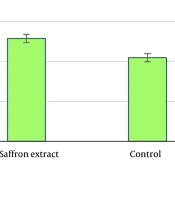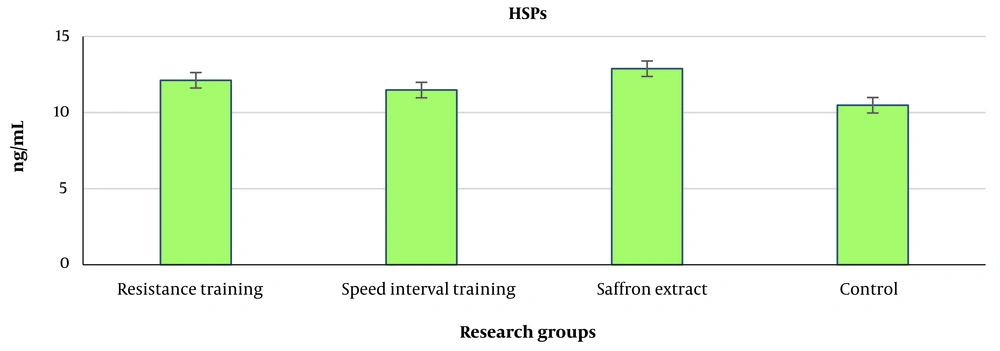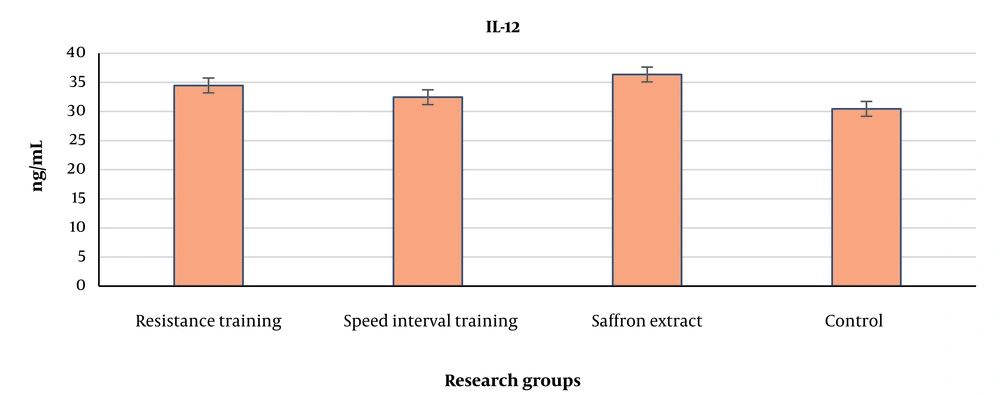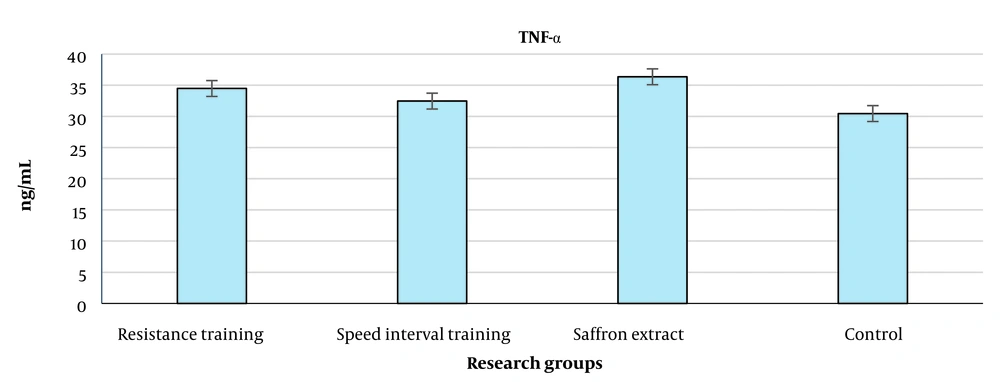1. Background
Type 2 diabetes is a common chronic disease globally, marked by issues in insulin production and utilization, which regulates blood glucose levels. This condition significantly impacts the body’s immune and inflammatory systems, with chronic inflammation and elevated inflammatory factors posing risks for complications associated with diabetes. Exercise is recognized as an effective strategy for managing type 2 diabetes, with resistance training and high-intensity interval training (HIIT) being two widely used methods. Both approaches have been validated for improving diabetes-related factors and reducing inflammation (1). Additionally, natural compounds like saffron extract have shown promise in positively influencing type 2 diabetes management. Known for its anti-inflammatory and antioxidant properties, saffron may improve inflammatory factors linked to diabetes. Thus, these natural compounds can complement physical exercise, enhancing diabetes control and inflammation management (2).
Previous studies indicate that physical activity significantly improves blood glucose control, insulin sensitivity, and inflammatory factors in type 2 diabetes patients. Resistance training enhances glucose uptake in muscles and improves insulin sensitivity, while HIIT stabilizes blood sugar levels and boosts glucose utilization. Saffron extract is also recognized for its ability to reduce inflammatory factors, including heat shock proteins (HSPs), interleukin-12, (IL-12) and tumor necrosis factor alpha (TNF-α|) in diabetic patients (3). However, past studies examining the effects of physical exercise and saffron extract on inflammatory factors in type 2 diabetes have been limited and sometimes inconsistent. Some research suggests that combining resistance training and HIIT with saffron extract effectively controls HSP levels and inflammatory factors, leading to significant improvements in diabetic patients. Conversely, other studies report varying results, indicating that the impacts of these exercises and saffron extract on inflammation may differ (4). Given the importance of managing inflammatory factors in type 2 diabetes and the need to identify optimal exercise methods alongside saffron extract use, this research aims to deepen our understanding of the biological and therapeutic mechanisms of the disease. Specifically, the study investigates the effects of eight weeks of resistance training and HIIT combined with saffron extract on HSP levels and inflammatory factors, including IL-12 and TNF-α, in male Wistar rats with diabetes. Conducting this research may yield several key insights. Firstly, the results may clarify how resistance training and HIIT affect inflammatory factors in type 2 diabetes, demonstrating a positive impact on controlling inflammatory markers such as HSPs, IL-12, and TNF-α. These findings could indicate a substantial improvement in the inflammatory status of diabetic patients, contributing to advancements in disease management (5). Moreover, natural compounds like saffron extract have gained attention for their potential therapeutic benefits in various health conditions, including diabetes (6, 7). The combination of HIIT and saffron extract may influence the expression of HSPs, IL-12, and TNF-α in diabetic rats. The HSPs are proteins known for their protective cellular functions and roles in stress responses and protein folding (8). The IL-12 is a cytokine that regulates immune responses (9), while TNF-α is a pro-inflammatory cytokine involved in various chronic diseases, including diabetes (10). This study aims to clarify the underlying mechanisms for the therapeutic benefits of physical activity and saffron supplementation in diabetic individuals by examining their effects on these biomarkers (11). Selected exercise methods, such as resistance training and HIIT, represent distinct approaches with varying impacts on the body’s physiological responses (12). Resistance training enhances muscle strength, while HIIT consists of short bursts of intense exercise followed by rest periods (13). Understanding the effects of these exercise modalities, alongside saffron extract supplementation, on the expression of HSPs, IL-12, and TNF-α in diabetic rats is significant for advancing knowledge of exercise benefits in diabetes management (14). Moreover, exploring the potential role of saffron extract as an adjunct therapy may lead to new strategies for improving health outcomes in individuals with diabetes (15-17). Ultimately, this study aims to contribute to existing knowledge by examining the effects of resistance training and HIIT combined with saffron extract on HSPs, IL-12, and TNF-α in diabetic rats. The findings could inform novel therapeutic approaches and interventions aimed at improving diabetes management and its complications, enhancing the quality of life for individuals with this chronic disease (16).
2. Objectives
The aim of the study was to compare the effects of 8 weeks of resistance training and HIIT combined with saffron extract on HSPs, IL-12, and TNF-α in male Wistar rats with diabetes.
3. Methods
3.1. Animals
Thirty-two male Wistar rats, aged 14 months, with an average weight of 375 ± 55 grams, were purchased from the Pasteur Institute and transferred to the laboratory. A one-week period was allocated for their acclimatization to the laboratory environment and the treadmill. After the rats were transferred to the laboratory, they were kept in an environment with a temperature of 22 ± 1.4 degrees Celsius, humidity of 55 ± 4%, and a light-dark cycle of 12:12 hours. The animals had free access to food throughout the protocol. The research groups consisted of four groups: Resistance training, HIIT, saffron extract, and control. To induce severe diabetes, STZ was injected intravenously at a single dose of 40 - 50 mg per kilogram of body weight. After approximately three days, the blood glucose level of the animals reached over 300 mg per deciliter of blood.
3.2. Resistance Training Protocol
Each session of the resistance protocol was a progressive protocol that included 8 sets of climbing a ladder with progressively added weight attached to the proximal tail of the rat. Metal weights were gradually added inside a bag connected to the rat’s tail, which was secured to the tail of the animal with a strap. Each set consisted of 8 to 12 repetitions until reaching the upper rest box. The weights added to the rats’ tails in the first and second sets were equal to 50% of the animal’s body weight, in the third and fourth sets 75% of body weight, 90% for the fifth and sixth sets, and in the final load 100%. During the rest intervals between sets, the rats rested in the upper box for 60 seconds. The weights used were small rectangular metal shavings weighing approximately 3 grams, which were placed in a bag and secured to the proximal tails of the rats with adhesive tape. The training sessions for each animal lasted between 20 to 30 minutes (18).
3.3. High-intensity Interval Training Protocol
The HIIT was conducted over eight weeks, starting with six sessions in the first week and five sessions in the following weeks on a rodent treadmill (Pishro Andisheh Sanat Company, Iran). The initial week involved running at speeds of 30 to 45 meters per minute for one minute across 10 intervals, with two minutes of active rest (at 8 meters per minute) between intervals. In the last three weeks, the speed increased to 75 to 85 meters per minute for one minute with seven intervals, allowing for three to four minutes of rest between each interval. To prevent overtraining in the fifth week, the treadmill speed was reduced to 50 meters per minute for one minute with five intervals and five minutes of rest, ensuring proper recovery before the final three weeks of intense training. Each session began with a five-minute warm-up at 10 meters per minute and concluded with a five-minute cool-down at 6 meters per minute (19).
3.4. Saffron Extraction Method
In this study, to extract the saffron petal extract, the percolation method with ethanol extract was used, which has the highest amount of antioxidants, and its effectiveness and method were proven by Afraze et al. (20). The groups consuming the saffron extract received it daily at a dosage of 33 mg/kg through gavage (the weights of the rats were recorded weekly, and the amounts of saffron were gavaged based on the rats’ weights in grams). The control group similarly did not receive any supplements.
3.5. Data Analysis Method
Statistical analyses were conducted using SPSS version 24, with data expressed as mean ± standard deviation. The Shapiro-Wilk test assessed the normal distribution of continuous variables. Group comparisons were made using mixed ANOVA, followed by Tukey’s post-hoc test. A significance level of less than 0.05 was set.
4. Results
Table 1 shows the changes in the weight of the rats during the study period across different research groups. Table 2 shows the mean values of HSPs, IL-12, and TNF-α in the research groups. To determine the normality of the data, the Shapiro-Wilk test was used. The results of this test are presented in Table 3. The results indicate that the normality condition for the variables in the present study is satisfied. The results in Table 4 indicate that there is a significant difference between the research groups in the HSPs variable (P ≤ 0.05). The results in Table 5 indicate that there is a significant difference between the research groups in the IL-12 variable (P ≤ 0.05). The results in Table 6 indicate that there is a significant difference between the research groups in the TNF-α variable (P ≤ 0.05). Figure 1 shows the mean values of HSPs in research groups after eight weeks of exercise and nutritional interventions. Figure 2 shows the Mean values of IL-12 in research groups after eight weeks of exercise and nutritional interventions. Figure 3 shows the Mean values of TNF-α in research groups after eight weeks of exercise and nutritional interventions.
| Groups | Control | Saffron Extract | HIIT | Resistance Training |
|---|---|---|---|---|
| Day 1 | 167.52 ± 14.89 | 171.41 ± 13.49 | 177.87 ± 10.72 | 168.02 ± 16.05 |
| Before last training session | 258.58 ± 22.56 | 291.61± 43.53 | 283.10 ± 35.02 | 266.96 ± 46.42 |
Descriptive Data of Changes in Rat Weight During the Study Period
| Variables | Resistance Training | HIIT | Resistance + Interval + Saffron | Control |
|---|---|---|---|---|
| HSPs | 12.12 ± 0.28 | 11.48 ± 023 | 12.88 ± 0.25 | 10.48 ± 0.23 |
| IL-12 | 34.48± 0.77 | 32.46 ± 0.51 | 36.36 ± 0.30 | 30.46 ± 0.51 |
| TNF-α | 18.16 ± 0.36 | 17.18 ± 0.23 | 19.64 ± 0.27 | 16.18 ± 0.23 |
Mean and Standard Deviation of Research Variables
| Groups | Control | Saffron Extract | HIIT | Resistance Training |
|---|---|---|---|---|
| HSPs | 0.82 | 0.89 | 0.95 | 0.89 |
| IL-12 | 0.22 | 0.61 | 0.94 | 0.61 |
| TNF-α | 0.88 | 0.89 | 0.98 | 0.89 |
Normality Test of Research Data Using Shapiro-Wilk Test
| HSPs | Degrees of Freedom | Mean Squares | F-Value | Significance Level | Eta Squared | Power |
|---|---|---|---|---|---|---|
| Stage | 1 | 2756.55 | 41924.74 | 0.001 | 0.99 | 1.00 |
| Group | 3 | 5.16 | 78.56 | 0.001 | 0.93 | 1.00 |
| Error | 16 | 0.06 | - | - | - | - |
Results of Mixed ANOVA for Heat Shock Proteins
| IL-12 | Degrees of Freedom | Mean Squares | F-Value | Significance Level | Eta Squared | Power |
|---|---|---|---|---|---|---|
| Stage | 1 | 22364.67 | 73967.93 | 0.001 | 1.00 | 1.00 |
| Group | 3 | 32.41 | 105.75 | 0.001 | 0.95 | 1.00 |
| Error | 16 | 0.30 | - | - | - | - |
Results of Mixed ANOVA for IL-12
| TNF-α | Degrees of Freedom | Mean Squares | F-Value | Significance Level | Eta Squared | Power |
|---|---|---|---|---|---|---|
| Stage | 1 | 6329.68 | 79121.02 | 0.001 | 1.00 | 1.00 |
| Group | 3 | 10.87 | 135.90 | 0.001 | 0.96 | 1.00 |
| Error | 16 | 0.08 | - | - | - | - |
Results of Mixed ANOVA for Tumor Necrosis Factor Alpha
5. Discussion
In the studies by Hasanvand et al. and Dehghan et al., saffron extract was found to enhance diabetic parameters and reduce oxidative stress in diabetic patients (12, 16). These findings correlate with our study, which explored the effects of exercise and saffron extract on HSPs and inflammatory cytokines in diabetic rats. Hosseini and Hosseini reported that HIIT combined with resveratrol, an antioxidant, increased IL-10 levels while decreasing TNF-α levels in diabetic rats, which supports our results on the combined effects of resistance training and interval training with saffron extract on cytokine levels (15). Dehghan et al. highlighted saffron extract’s role as a potent antioxidant, suggesting its ability to mitigate oxidative stress in diabetic and cardiovascular patients. This aligns with our findings concerning the impact of exercise and saffron extract on HSPs in diabetic rats. Our comparison emphasizes the synergistic effects of physical exercise and saffron extract on heat shock and inflammatory parameters in diabetic patients. Moreover, research indicates that saffron extract may offer cardiovascular protection, further underlining the significance of combining exercise and saffron extract for improving cardiovascular health in diabetic individuals (16, 17). Our results revealed significant differences in HSP levels across all research groups compared to the control group, indicating that both resistance training and HIIT, along with saffron extract, positively influence HSPs in diabetic rats. This suggests that these interventions are effective in reducing oxidative stress and enhancing inflammatory conditions in diabetes (16). Thus, resistance training and HIIT combined with saffron extract appear to enhance HSP levels, which can improve oxidative stress and inflammatory status in diabetes. The mechanism of HSPs involves their response to thermal stress, providing cellular protection against such shocks and maintaining balance in cellular reactions. When cells encounter thermal shock, HSP levels rise, aiding in the stabilization and repair of damaged proteins. This functionality highlights their essential role in cellular maintenance and reconstruction (21). Additionally, HSPs support cellular defense mechanisms and repair processes by regulating gene activity and signaling pathways. Therefore, they are crucial for cellular stability and stress protection. Our findings suggest that resistance and HIIT combined with saffron extract can elevate HSP levels in diabetic rats, indicating potential improvements in oxidative stress and inflammatory conditions (22). Furthermore, both exercise modalities, alongside saffron extract, show promise in enhancing the protective mechanisms of HSPs against various stresses. Moreover, our research indicates that resistance training and HIIT combined with saffron extract can significantly improve IL-12 levels in diabetic rats. As an inflammatory cytokine, a reduction in IL-12 may reflect an improvement in the inflammatory status associated with diabetes (23). Thus, it can be concluded that these combined interventions may accelerate the management of inflammatory conditions in diabetes, suggesting that exercise programs with saffron extract could mitigate inflammatory complications (24). However, further investigation is necessary to validate these claims, and any therapeutic or exercise approach should be pursued under medical guidance (25). The increase in IL-12 typically occurs during high inflammatory states. Resistance training and HIIT can lower systemic inflammation, which may contribute to reduced IL-12 levels (26). These exercise forms can enhance immune function, leading to better regulation of cytokines such as IL-12. Diabetes often disrupts glucose metabolism; therefore, effective blood glucose control through exercise can further decrease inflammatory levels and IL-12 (27). Saffron extract, known for its antioxidant properties, may also contribute to lowering oxidative and inflammatory stress, thus aiding in IL-12 reduction. Overall, the mechanisms by which resistance training and HIIT, along with saffron extract, improve IL-12 levels in diabetic rats include inflammation reduction, immune system regulation, and blood glucose control. Additionally, our results indicate that these interventions can significantly lower TNF-α levels in diabetic rats, suggesting a potential for improving inflammatory status in diabetes (28). Cell signaling pathways and transcription factors are crucial for regulating the expression of HSPs, IL-12, and TNF-α. When cells face stressors like heat or infection, these pathways activate HSP production to protect proteins. Concurrently, transcription factors such as NF-κB and STAT3 regulate the genes for IL-12 and TNF-α. The IL-12 enhances T-cell responses, while TNF-α regulates inflammation. Thus, the interplay between these pathways and factors ensures a precise immune response to stress and infection (29).
5.1. Conclusions
Resistance training and HII.T combined with saffron extract can lead to improvements in the inflammatory status of diabetes. By reducing the levels of Hcy, CRP, and TNF-α, the inflammatory status in the body decreases, which can contribute to the overall improvement of diabetic patients. This anti-inflammatory effect may assist in regulating the immune system and reducing the activity of inflammatory cytokines. However, further research and clinical studies in humans are needed to more accurately confirm these effects.
5.2. Limitations
The present study was limited to diabetic rats, and among the inflammatory factors, only HSP, IL-12, and TNF-α were measured.



